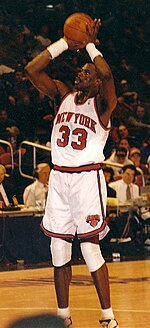Forward-center
This article has multiple issues. Please help improve it or discuss these issues on the talk page. (Learn how and when to remove these template messages)
|

Forward–center is a
power forward and center
, since these are usually the two biggest player positions on any basketball team, and therefore more often overlap each other.
Forward–center came into the basketball jargon as the game evolved and became more specialized in the 1960s. The five positions on court were originally known only as
power forward, and center
.
Typically, a forward–center is a talented forward who also came to play minutes at center on teams that need help at that position. The player could also be a somewhat floor-bound center, under 7' 0'' (213 cm) tall at the
NBA with 7′ 0″ (213 cm) Patrick Ewing. Ewing himself also played forward-center early in his career to complement the then-incumbent Knicks center, 7′ 1″ (216 cm) Bill Cartwright. Fellow Knicks legend Willis Reed was moved to the forward–center position when the team acquired fellow center Walt Bellamy in 1965; Reed moved back to center in 1968 after the Knicks traded Bellamy to the Detroit Pistons for Dave DeBusschere. Ralph Sampson, at 7′ 4″ (224 cm), was another notable forward–center who played center his rookie year in 1983. In 1984, he moved to power forward when 7′ 0″ (213 cm) Hakeem Olajuwon
was drafted that year. Most forward-centers range from 6′ 9″ (2.06 m) to 7′ 0″ (2.13 m) in height.
Other notable forward-centers include: Kevin Garnett, Tim Duncan, Pau Gasol, Chris Bosh, LaMarcus Aldridge, Anthony Davis, Al Horford, Bam Adebayo, and Giannis Antetokounmpo.
See also
- Tweener
References

